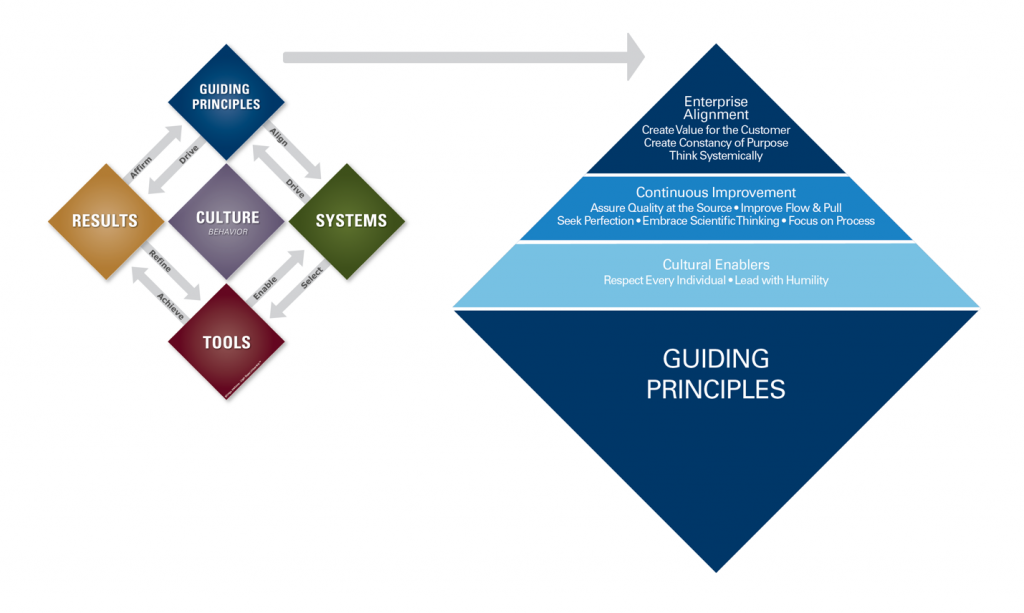Changing the Shingo Model™ to Accelerate Learning
Over the past several months, I have analyzed and discussed the Shingo Model™ on this blog and in private meetings with thought leaders. This has led to a lot of feedback from various people – both in response to Shingo blog posts, to my personal LinkedIn account, and in one-on-one conversations. I deeply appreciate the passion and commitment of so many people to the Shingo Model™!
Any recommendations made by me were based entirely on direct observation of the learning process during the Shingo workshops. In other words, how could we change the Model that would help people learn it better or faster in that setting? As we all know, there are many other considerations to take into account than just the classroom learning experience. The feedback has helped clarify some of these other considerations which must be taken into account.
Let me do my best to articulate different concerns that have been raised:
Unintended Consequences
Changing the current wording of a principle may introduce negative, unintended consequences. An example shared with me by several senior executives is the proposal to change “Assure Quality at the Source” to “Control Quality at the Source.” These executives explain that they work hard to destroy the typical “command and control” culture in their organizations through “Leading with Humility,” and changing this wording would run counter to these efforts. This never occurred to me. If a word change such as this runs counter to efforts to build the right kind of culture, it truly would be an unintended consequence. We need to avoid causing new problems while trying to make improvements.
Don’t Diminish Robust Learning Experiences
While some principles may take some time for people to understand, in most cases, people inevitably get to an understanding. Often, this learning process creates an “aha!” moment that they will remember. Some of the experienced Shingo facilitators pointed out to me that this is the case with the proposal to change “Create Constancy of Purpose” to “Unify Around a Common Purpose.” These facilitators all agree that eventually everyone needs to understand that purpose doesn’t drive behavior unless people are unified around that purpose. But, as I have observed, the participants in the workshop ALWAYS get to this understanding. And they learn a lot in the process. The facilitators suggest that being too explicit in the wording of the principle will diminish the robust learning experience. It’s a great point! We do not want to diminish a learning experience that is working.
Change for the Sake of Change is a Waste
The Shingo facilitators who suggested that some of the changes might diminish the learning experience also suggested that in the case where the learning is being achieved, that any changes will just create waste. Change for the sake of change is just another waste! Changing “Create Constancy of Purpose” to “Unify Around a Common Purpose” might be an example of change for the sake of change waste.
Don’t Detract from the Assessment Process
Many of you may be aware that we have a group of senior examiners who govern the Shingo Prize assessment process. We shared potential Model changes with this group. While they did not comment on any specific changes under consideration, they did make a general comment that the current assessment process using the existing Model is working very well. They report that the current Model leads to a fair and accurate assessment of organizations that apply for the Shingo Prize. They suggested that we need to make sure we don’t change something that might detract from this process that is working.
Too Many Principles?
Many senior executives pleaded with me to make sure we cap the number of principles at 10. They report that people in their organizations struggle with remembering, thinking about, and implementing 10 principles. They are concerned that additional principles – at least at this point in time – will lead to incremental confusion and will negatively impact their internal training. These executives asked that if we have additional concepts that we want to articulate in the form of a new principle that, instead, we find ways to integrate these concepts into existing principles. In short, they requested that we keep the Model as simple as possible. We find the request to keep the learning process as simple as possible compelling. We find the request to keep the learning process as simple as possible while putting a cap on the number of principles to be a challenge. We suspect this will be an on-going challenge.
Where Does That Leave Us? Shingo Model™ Changes
After careful consideration we have decided to make some changes.
First, there will not be any changes to the Shingo Model configuration, but we have created more consistent color codes for each of the elements in the Shingo Model as follows:
- Results = Gold
- Principles = Blue, with variations in shade to represent the three different dimensions (see explanation below)
- Systems = Green
- Tools = Red
- Culture = Purple
The placement and wording will all remain the same with the exception of some clarifications we’ve made in the way we present the Guiding Principles.
The Guiding Principles
- We eliminated the Results dimension in the Guiding Principles pyramid. Having it there was hindering proper understanding of Results as an element of the Shingo Model.
- Accordingly, we moved the principle “Create Value for the Customer” to the Enterprise Alignment dimension.
- We changed the wording of the principle about flow and pull to “Improve Flow and Pull,” as discussed in a previous blog about this principle. This will clarify what the Shingo Institute prescribes for this principle.
- Everything else about the wording of the Shingo Guiding Principles themselves will stay the same. The principles resonate with people, perhaps more than any other part of the Shingo Model, and that may be the most important role they play.
- While people who understand it know that the principles pyramid has always been just a part of the Shingo Model and not the Model itself, we have found that people new to the Model are sometimes confused about it. Part of that has likely stemmed from the way we were using the colors in the pyramid. In order to make it clearer that the principles pyramid is part of the Guiding Principles diamond at the top of the Model (which has always been blue), all three dimensions of the pyramid will now be distinguished using different shades of blue. We’ll also take care to display the principles in ways that will make it clearer how they fit with the Model.
To explore this model in detail, please join me in the Discover Excellence workshop at the 11th annual Lean Healthcare Transformation Summit, in Salt Lake City, UT. Or visit shingo.org.
Ken Snyder, Executive Director
The Shingo Institute
Related Items
Discover Excellence workshop
The Lean Healthcare Transformation Summit
The Shingo Conference and Awards Gala











Leave a Reply